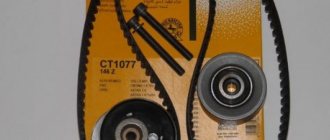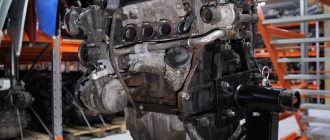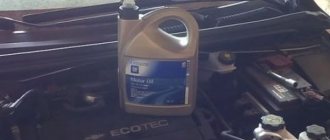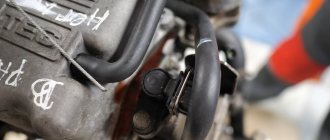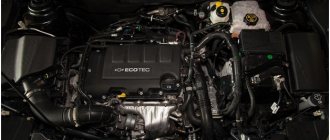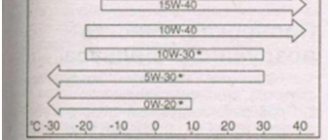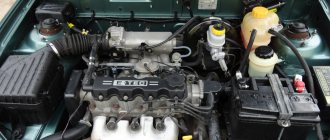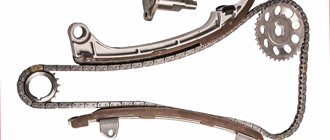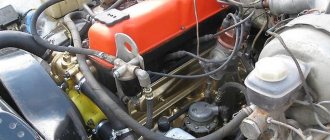Chevrolet Aveo is the brainchild of GM Daewoo, a subsidiary of General Motors in Korea. The car was designed by Giorgetto Giugiaro based on the Daewoo Lanos compact car (model T100). The Italian studio ItalDesign worked on the appearance of the urban small car.
Chevrolet Aveo first generation T-200 (2003-2008)
Model history
The first Aveo (model T200) went on sale in 2003 in 3-door, 5-door hatchback and sedan body styles. In 2006, the Chevrolet Aveo sedan was restyled, and in 2008, the hatchback was also restyled. Both newcomers received the designation T250. During the update process, the Aveo's appearance, interior and engine range were adjusted. In 2011, it was replaced by a second generation model, the T300.
The car appeared on the Russian market in 2004. Later, Chevrolet Aveo in 5-door hatchback and sedan bodies for Russia began to be assembled in Kaliningrad at the Avtotor enterprise.
Engines
The pre-styling Chevrolet Aveo was equipped with the B12S1 1.2 liter (72 hp) and F14D3 1.4 liter (94 hp) engines. All units received a timing belt drive with a replacement schedule every 60 thousand km. Both engines have the same cylinder blocks and crank group. A significant difference between the units lies in the cylinder head. The B12S1 has one camshaft with 2 valves per cylinder, and the F14D3 has two camshafts with 4 valves per cylinder. 1.4 liter engines are equipped with hydraulic compensators.
The 1.2 liter B12S1 has one serious “sore”, acquired as a result of an unreasonably high oil change interval of 15,000 km. In difficult Russian operating conditions with poor gasoline and cold winters, it is better to reduce the replacement interval to a maximum of 10 thousand km, and even less for long runs. Otherwise, with a mileage of more than 60 - 100 thousand km, increased wear of the camshafts with rocker arms and its axles is observed. In the worst case, after 100 - 150 thousand km, the camshaft may jam, followed by an expensive (about 50 thousand rubles) replacement of the cylinder head.
A harbinger of trouble will be the appearance of a clicking sound or “diesel sound”. The cause of the trouble is a clogged oil line nozzle, which causes oil starvation. If a defect is detected, it is necessary not only to replace the camshaft with rockers, but, by removing the cylinder head, clean the jet and drill the hole to a larger size. Otherwise, “dieseling” and wear will soon begin again. But there is no need to be too upset. With proper care, 1.2 liter engines can easily exceed the 300 thousand km mark without major repairs.
The front crankshaft oil seal on these engines begins to leak after 100 - 140 thousand km (1.5 - 2 thousand rubles with work). In cold weather, with a mileage of more than 80 - 120 thousand km, due to jamming of the crankcase ventilation valve, the oil dipstick is often knocked out and the oil is squeezed out.
Chevrolet Aveo first generation T-200 (2003-2006)
The F14D3 engine may begin to “tweak” at high mileage and interruptions in its operation may occur. The reason is hanging exhaust valves due to carbon deposits. Since 2008, the valves for these engines have been improved, and problems no longer arise. Also, 1.4 liter engines are characterized by oil leakage from under the valve covers with a mileage of more than 80 - 120 thousand km (200 - 1200 rubles).
After restyling in 2008, the power units were also updated. The B12D1 1.2 l (84 hp) engines with a timing chain drive and the F14D4 1.4 l (101 hp) engines with an automatic valve timing adjustment mechanism appeared.
A “one hundred strong” engine produced before 2010 with a mileage of more than 30 – 60 thousand km “suffers” due to the failure of the camshaft gear. It gives itself away by “rumble” immediately after start-up and by “dieseling” during warm-up. Repairs will cost 20–30 thousand rubles including work. If the “disease” is started, it can squeeze out the camshaft seals with a subsequent drop in the oil level. If oil gets on the timing belt, it may skip several teeth, and, as a result, the valves will meet the pistons. Interruptions in engine operation with “Check Engine” displayed after 60–80 thousand km can be caused by a break in the contact circuit on the ECU plug. To restore engine functionality, you just need to tighten the terminals on the plug.
Next, we note the malfunctions characteristic of all types of Chevrolet Aveo engines. With a mileage of more than 40 - 80 thousand km, the expansion tank cap begins to “siphon” (about 400 rubles) due to a stuck valve. The thermostat of 1.4 liter engines is returned after 60 - 90 thousand km (1000 - 3000 rubles). Over time, it begins to leak or open too early, preventing the engine from warming up in cold weather. With a mileage of more than 60 - 80 thousand km, the radiator cooling fan may stop turning on (usually on 1.4 liter engines) due to problems with the contacts in the connection connector, or less often due to “sticking” of the fan motor brushes.
On Chevrolet Aveo produced from 2003 to 2007, it is common to rub the radiator “to the holes” (in the lower right corner) with the fan casing after a mileage of more than 40 – 80 thousand km. To avoid this, it is necessary to place washers in the places where the fan frame is attached and slightly trim the edge of the casing. A new radiator will cost 3–5 thousand rubles for a non-original one and 8–9 thousand rubles for an original one.
A burning "Check Engine", interruptions in engine operation and decreased traction with a mileage of more than 80 - 120 thousand km can be caused by a clogged filter mesh of the fuel pump in the tank, failure of high-voltage wires (650 - 1800 rubles), oxygen sensor (1000 - 3300 rubles) or catalyst.
Used Chevrolet Aveo T200-250: automatic, which is better than manual, and engines with German roots
Transmission
It would seem that what could break down in the transmission of a car whose most powerful engines are just over 100 horsepower?
You won’t believe it, but it is in terms of mechanics that the Chevrolet Aveo has obvious punctures. The CV joint boots and the joints themselves are not particularly durable; even on cars with a weak 1.2, these parts fail after driving for one and a half hundred thousand kilometers. Lightly tapping CV joints can last quite a long time; many particularly thrifty drivers do not change a part that seems to be out of order and only stuff more lubricant under the new boot. Surprisingly, the design lasts for tens of thousands of kilometers.
In the photo: Chevrolet Aveo 5-door (T200) '2003–08
Most cars are equipped with manual transmissions of several series. All of them trace their origins back to Opel’s F10/F13 gearboxes and even remain interchangeable with them. True, Korean cars do not use high-tech release bearings combined with a hydraulic cylinder; they make do with a classic “release bearing” with a fork.
The design of the D13 box, which was installed with 1.2 engines, is frankly unsuccessful. It's just a collection of bad decisions in manual transmission design. Thus, weak bearings often began to hum at mileage of up to 70 thousand. The shafts are relatively reliable, and repairs in the event of severe wear are relatively inexpensive. But the synchronizers also fail, the fifth gear gets stuck, the differential suffers from welding of the satellite axle... And on top of that, the oil seals still leak, which often leads to the “draining” of the gearbox and its rapid death. In general, as in the song, “life is on the edge”...
Pictured: Chevrolet Aveo Sedan (T250) '2006–11
To prevent the boxes from dying in batches, the oil change intervals were repeatedly shortened during the warranty period - the latest unofficial recommendations suggested changing it once every 30 thousand kilometers. Unfortunately, many car owners consider this unnecessary. By the way, regular ATF works great in the box instead of the original oil; this is a frequently practiced substitution. But it’s still better to change the box to D16, even if this entails some modifications to the mounts and replacement of the drives.
In stock D16 is used for 1.4 and 1.6 engines. This manual transmission also has Opel roots and is close in design to the F16. The only trouble that remains here is oil leaks through the seals. Otherwise, this is a fairly strong unit - in any case, it gets along with such weak engines without problems.
Cost of front brake pads
for the original
2,077 rubles
Against the backdrop of troubles with the manual transmission, the operation of the Aisin automatic transmission looks like the height of reliability. After all, they installed a 60-41SN/60-40LE gearbox here, which easily withstands the torque of 1.4 and 1.6 engines and does not even overheat. With regular oil changes, it can withstand 200-250 thousand kilometers until the first repairs - replacing the gas turbine linings and cleaning the valve body and replacing the linear pressure solenoid. And even for “racers” who do not change their oil on time, the first problems rarely appear before 150-200 thousand mileage.
Noticeably less common with 1.4 engines is a weaker version of the automatic transmission, Aisin 81-40LE. This version of the box is essentially little different from the 60-40LE, but withstands noticeably less torque. In addition to all of the above, the planetary gear is also at risk. However, it is still less hassle than with a manual transmission, and with careful operation, the service life also exceeds 200-250 thousand kilometers before major repairs.
Motors
The Aveo didn’t have that many engines, but nevertheless, there is a little confusion. Many people still call the engines of the E-TEC II family “Opel”, although they have never installed them on European cars.
In general, all E-TEC units are developed based on GM licenses and Opel developments, but modified by Daewoo and manufactured in Korea or Australia. Despite the common design, there is a difference with European models.
Articles / Used Chevrolet Aveo T200-250 hatchback: delicate metal body and seats for thin people I’ll now say a seditious thing: Aveo is one of the most iconic Russian cars, which is now almost forgotten by the public. But soon her star will rise again. 16764 7 3 08/15/2017
Before restyling in 2007, B12S1 and F14D3 engines with a camshaft belt drive were installed. These are related engines on a modified Family I block. True, the 1.2 engine has only 2 valves per cylinder, and the 1.4 already has 4 - respectively, and the cylinder heads are significantly different.
After restyling, the engines were replaced with B12D1, this is the Family 0 family with a timing chain drive and 16 valves and the F14D4 engine, which belongs to the “old” Family 1 family and has a timing belt drive, but in design is more reminiscent of European engines and therefore is called by many “ Opelevsky".
It is quite easy to distinguish the motors. Which 1.2 is installed can be seen from the design: the new engine is smaller and its timing casing is not visible - it is a chain engine, after all. 1.4 engines can be distinguished by their nameplate power: the newer one has 101 hp, versus 94 for the old one. Well, on the top cover the inscription “Ecotec” proudly displays instead of “E-TEC”. The shape of the timing case and the location of the attachments are also different.
All belt motors have a well-developed design with sufficient service life. Even small 1.2s can travel 200-250 thousand kilometers before a major overhaul with replacement of the piston group, and when using high-quality oils and short replacement intervals, the mileage before intervention in the piston group will be more than 350 thousand, there are plenty of such examples.
But, unfortunately, there are nuances. At a minimum, all owners will encounter leaks of seals and gaskets. After all, the crankcase ventilation system here is primitive and needs to be cleaned, and the hole in the throttle body simply becomes clogged. Oil seals should be changed whenever possible, and gaskets should only be used fresh, without reinstalling.
The cooling system is not made of the best materials and is prone to cracking of pipes, expansion tank and thermostat. The latter is not very scary, because the temperature drops minimally, which makes life easier for older engines in hot climates, but in winter, owners suffer from underheating of the interior.
Radiator cost
for the original
8,933 rubles
Plastic cylinder head covers on 16-valve 1.4 engines are also not ideal; there are frequent cases of warping and oil leaks into spark plug wells. Well, the EGR valve on all engines not only heavily pollutes the intake manifold, but also jams , significantly reducing engine power and service life.
Motors with catalytic collectors also risk the piston group when it falls off; this usually happens with runs of more than 150-200 thousand kilometers, but starts in severe cold can lead to earlier failure of the catalyst. Well, leaks in the gas tank ventilation system due to the tube rubbing against the rear shock absorber can lead to its contamination and problems with the pump and injectors.
There are also troubles specific to each engine model, and more serious ones. For eight-valve 1.2 B12S1, if oil change intervals of 10 thousand kilometers are not observed or low-viscosity oils are used for runs of more than 100 thousand kilometers, the camshaft beds can lift up. And this is a serious repair or replacement of the cylinder head . By the way, Opel ones with 8-valve engines or Nexia ones with 1.5 engines are suitable. The reason is a clogged oil supply nozzle. By the way, it is recommended to drill it out, if the motor is still alive, to a diameter of 1.2 mm. And the timing belt needs to be changed not according to the regulations, but after 60 thousand mileage, and together with all the rollers. And change the pump no less often than after one timing belt replacement.
L-arm cost
for the original
3,976 rubles
The restyled B12D1 engines have a relatively short timing chain resource, about 100-150 thousand kilometers. And therefore it is worth listening carefully to the sounds of the chain during a cold start. The chain is thin and breaks easily, but more often it just jumps and bends the valves.
With F14D3 engines the situation is even more unpleasant. Incorrectly selected clearances in the valve-bushing pair cause them to “hang,” which over time leads to burnouts and other unpleasant consequences, including destruction of the camshafts. The recall campaign has long passed, but there are still cars that have been suffering from this problem for a long time, and the owners valiantly ignore all the symptoms.
Poor starting and decreased compression for this engine with mileages of up to 150 thousand kilometers most often mean a quick repair of the cylinder head. Well, or replacing it with an Opel one, which is also a good option and even cheaper. High-voltage wires also need to be changed regularly; often the engine loses a lot of power precisely because of them. The intake manifold becomes dirty, the vacuum drives do not work correctly, the throttle becomes clogged, and the idle air valve requires regular cleaning.
The F14D4 is initially free from such a problem, but it also has its own subtleties. Thus, the condition of the intake manifold flaps most often does not allow the development of full power: EGR and oil from the crankcase ventilation system are to blame, as well as weak plastic flaps.
Individual ignition coils are noticeably more expensive than wires and ignition modules, and they easily fail due to oil leaks. So you will have to regularly, at least once every 60 thousand, change the cylinder head cover gaskets if you do not want to change more expensive parts. Phase regulators may knock when starting up. The problem is most often in the valves or contamination of the valve nets, but if you drive for a long time with a knock, then the phase regulator couplings themselves will require replacement.
And watch out for oil leaks from the couplings, otherwise the timing belt may fail much earlier than expected. The valve clearances need to be adjusted - the engine does not have hydraulic compensators. The electronic throttle requires regular cleaning , otherwise there may be drops in speed when switching and strong idle “swimming”.
The rare 1.6 engine is usually the F16D4, like on the Lacetti , it was installed only on cars for the USA, so Aveo with such an engine is rare in our country. But in operation it is no different from F14D4 engines.
Pictured: Chevrolet Aveo Sedan (T250) '2006–11
Summary
The first generation Aveo is a very inexpensive car. True, it is not very cheap to operate - at least if you use dealer service and do not delve into the essence of the problems. And if you approach repair and maintenance wisely, then spare parts are inexpensive, and the work usually doesn’t cost exorbitant amounts of money, because everything here is quite simple.
But you have to come to terms with the fact that an elderly car with over 150 miles on it will most likely be constantly in a state of repairing something. Not a single breakdown will stop the car for a long time, and if you take care of the gearbox and avoid major difficulties with the engine, then it will not let you down at all in difficult times.
Ride quality and comfort? Well, it’s clearly higher than when moving on foot or in old Zhiguli cars. So if you need an inexpensive vehicle, and you're not afraid to put your hands and brains into repairs, then take a closer look.
Survey
Would you buy an Aveo for yourself?
Your voice
Total votes:
Transmission
The engines were paired with a 5-speed manual transmission. She did not show her best side - she often caused problems. The clutch lasts for at least 100–150 thousand km, but often it has to be changed earlier: because of the release bearing, which wears out after a mileage of 50–100 thousand km (1200–2500 rubles). The clutch kit will cost 6 thousand rubles including labor.
Hardened gearbox seals can leak after 80 - 130 thousand km. If you do not notice an oil leak during the process, its level in the box may drop significantly. Under conditions of oil starvation, wear occurs on the neutral and 5th gear gears. You need to be wary if a crunching sound appears when you turn on the 5th speed. Restoring the box will cost 10–12 thousand rubles including labor. In cars operated primarily in the city, problems with gear shifting accuracy may arise after a mileage of more than 60 - 100 thousand km due to wear and tear on the gear shift mechanism.
Chevrolet Aveo first generation T-250 (2008-2011)
A 4-speed automatic transmission was only installed in conjunction with the 1.4 liter engine. An “automatic” is much more reliable than its “manual” counterpart. The only problem that arises with a mileage of more than 40 - 100 thousand km is the gear selector locking in the “P” position. The reason is loss of contact in the microswitch that controls the solenoids. Cleaning the contacts briefly relieves the disease. It is better to replace the Mikrik. In addition, the box does not tolerate frequent and long slips, during which the clutches “burn quickly.” In this case, repairing the box will require about 60 - 70 thousand rubles.
Transmission
The lion's share of cars in this model are equipped with a 5-speed manual transmission. There will be no more than 20% of cars with a 4-speed automatic transmission. Both boxes suffer from poor sealing of the axle shaft seals and the crunching sound of the outer grenades. Therefore, sometimes these elements have to be changed. Otherwise, both gearboxes are quite reliable. The manufacturer has successfully eliminated several problems that were typical in the previous version of the car. The clutch has a hydraulic drive, which deserves only one comment - the noise of the release bearing.
Chassis
Things are not going well with the suspension either. Its peculiarity is a dull “mumbling” in the front, which appears in the first thousand. With the arrival of winter, the “booming” intensifies. The specific culprit has not yet been identified. Perhaps one of the main sources of “knock” is the front shock absorber mounts, which are helped by the shock absorbers themselves and the front stabilizer bar struts. In fact, “supports” (about 500 rubles), front shock absorbers (2 – 3 thousand rubles) and struts (200 – 300 rubles) last more than 60 – 80 thousand km. Front wheel bearings (400 - 1600 rubles) and rear shock absorbers last more than 60 - 100 thousand km.
The silent blocks of the rear arm of the front suspension (about 300 rubles) can creak after 50 - 60 thousand km. The silent blocks of the front lever are almost eternal. Silent blocks of the rear beam are handed over at a mileage of more than 80 - 140 thousand km (300 - 900 rubles). At the same time, creaks and knocks appear from behind, and road stability is significantly reduced.
The front brake pads last about 30 – 50 thousand km (400 – 2000 rubles), the discs themselves last up to 60 – 100 thousand km (1.5 – 2 thousand rubles). But the rear pads of the drum brake mechanism “put the pig down” with a mileage of 80 - 90 thousand km. The brake linings gradually peel off from the pads, which come off and jam the rear wheels. New pads will cost 600 – 900 rubles.
Problems with ABS with a mileage of more than 40 - 80 thousand km arise mainly due to broken wires from the system sensor or poor contact in the connector. The ABS blocks themselves (1-2 thousand rubles) fail very rarely.
Chevrolet Aveo first generation T-250 (2006-2011)
The Chevrolet Aveo steering rack may rattle when the mileage is more than 50 - 80 thousand km. The reason is backlash in the gear shaft due to wear of the right bushing. The steering shaft seal in the upper part of the rack may leak after a mileage of more than 80 - 100 thousand km. In this case, oil may appear under the driver's carpet. All defects are fixable. A new steering rack will cost 20–25 thousand rubles.
A special feature of the power steering pump is a noticeable hum when warming up in severe frosts. Sometimes it is possible to make the life of the pump a little easier by changing the oil to a fresher one.
Suspension
The chassis has high energy consumption and copes well with defects on our roads. However, during sharp maneuvering, the body tilts noticeably. Therefore, the car is more suitable for measured driving.
The design of the Aveo T250 suspension is similar to the previous version - independent McPherson strut in front and semi-independent beam in the rear. The suspension is well adapted to our realities and lasts quite a long time. Stabilizer struts can last up to 50 thousand km, but the silent blocks of the front arms, ball joints and stabilizer bushings usually last up to 100 thousand km.
Body and interior
Front panel of Chevrolet Aveo T-200 (2003-2008)
The paintwork does not present any major problems. On a Chevrolet Aveo younger than 2006, many drivers report damage to the rear wheel arches.
The aerodynamics of the body are such that at speeds of more than 90 – 120 km/h the cabin is filled with the whistle and howl of the oncoming flow. “Crickets” do not hide their love for the Chevrolet Aveo interior. Squeaking sources include the front panel, seat belt buckle, rear seat backrest buckle, and seat belt upper anchor. A squeak in the rear of sedans is often caused by a crack in the area of the rear parcel shelf. Over time, with a mileage of more than 80 - 100 thousand km, the seat belt return mechanism begins to work worse.
Comfort
With a mileage of more than 40 - 60 thousand km, the blower fan sometimes whistles. The reason is dirty motor bearings. The sound intensifies with the onset of cold weather. Treating the bearing with silicone grease helps for a short time; it needs to be replaced (160 rubles). A new motor costs about 4 thousand rubles.
On many Chevrolet Aveos, the air conditioning system is not fully charged with freon, which contributes to increased wear on the air conditioning compressor. The system itself often loses its tightness, making it almost impossible to determine the location of the leak. Freon disappears gradually, over 2–3 years.
Electrics
The electrics do not cause any major complaints. With a mileage of more than 60 - 120 thousand km, it may be necessary to replace the generator bearings. For two bearings, front and rear, you will have to pay only 400 - 600 rubles, the work costs about 1000 rubles. With a mileage of more than 60 - 80 thousand km, the headlight range control may stop working due to oxidation of the negative wire on the headlight. With a mileage of more than 80 - 120 thousand km, problems with the clock may arise due to a failed diode in the electrical circuit. You can replace the diode at any workshop that repairs electrical equipment.
Errors in the airbag control system will be indicated by a malfunction lamp that lights up for a few seconds when the ignition is turned on. If there are no errors in the system, it should “blink” several times and go out. The main cause of errors is a voltage surge or drop in the power supply circuit of the unit. For example, when trying to start the engine with a discharged battery or “lighting” another car with the ignition on. The unit itself rarely fails, and replacing it will require about 12 thousand rubles.
Front panel of Chevrolet Aveo T-250 (2006-2011)
Chevrolet Aveo II T300 (2012-present)
A car on the secondary market must be selected that is not old, inexpensive and common model. Such as the second generation Chevrolet Aveo. However, the Avechka, like any other car, has its pros and cons.
A small car with a famous name - this is the choice of many who are looking for an inexpensive car for every day. I think the Chevrolet Aveo fits this criterion almost perfectly.
The model, first shown in 2002, has Korean roots and Italian appearance. Body - sedan or hatchback. There is now only one engine for the Russian market - 1.6 liters (115 hp), and in addition to a five-speed manual, you can choose a six-speed automatic (in other countries the range is represented by engines with a volume of 1.2 to 1.8 liters, including 1 ,3‑liter diesel engine). The rest of the world, including Australia (where the car is produced under the Holden brand) and the States (where the Aveo is sold under the name Sonic), also knows this little car - after all, it is built on the global Gamma II platform. By the way, it underlies many of the concern’s models, providing a practically unsinkable basis for B-class vehicles and not only for them.
If you do not take into account the average crash test results, Aveo has proven itself well. Managed to survive two restylings and one radical generational change. It is the second version, which has been produced since 2011, that we will discuss.
For “trying on” I looked at the 2012 Aveo - a sedan with a 115-horsepower engine and a manual gearbox. Mileage 60,000 km. Price 410,000 rubles (as usual, negotiable). A sedan is better than a hatchback, which has a small trunk (unless you fold down the back seat). The mileage is high for two years, but the car is not a taxi: the owner is an air conditioning repairman, so he has accumulated the mileage. He assessed the condition of the car with the wording “get in and go.” The price range for two-year-old Aveos is from 370,000 to 600,000 rubles (a new car costs at least 549 thousand). Let's see if this copy will work out its 410,000 rubles.
When buying a new car, you don’t have to pay extra for just one exterior color – white. For an elegant blue one you will have to pay 9,000 rubles. And when you buy a car secondhand, you will get it for free.
The car looks good: two years of use have left no traces of hard life on it. But the head optics, designed in a motorcycle spirit, have already become old: the plastic of the low beam roundels has become cloudy. A new non-original headlight will cost no more than 3,500 rubles. Or you can simply polish the plastic. However, this is not as convenient as in the case of a single and indivisible plastic covering of the headlight.
One of the visible troubles is abrasion in the area where the rear wing meets the bumper. High-quality painting of one element will require about 5,000 rubles in Moscow. I wouldn't paint it, but I asked the seller for a discount. There are no other complaints about the body.
The instrument panel is also reminiscent of sportbikes. Highlighting the tachometer to the detriment of other instruments is a theme for high-speed cars. On the toothless Aveo, this is just a cute pretentiousness that does not interfere with the easy and free reading of the electronic speedometer and the generous scattering of indicator lamps.
Thick A-pillars cover a decent “firing sector”. The seller agrees with this: he says that when turning, you have to desperately turn your head. The interior hasn't gotten dirty yet, but you'll have to buy covers - the upholstery on the seats is too soft.
Some owners of versions with an automatic transmission encountered severe “sweating” of the oil seals: the oil in these automatic transmissions was filled in excess of the norm. Our car has a manual transmission, and there are no special problems with it.
While I was looking at the Aveo, I was humming the famous “March of the Aviators.” The one where “higher and higher we strive for the flight of our birds.” But the bird is ours at least!
Of course, in this size and in this price category it is difficult to come up with something stunning, but the second generation of the car got rid of such problems as weak anti-corrosion protection and body cracks at the welding points along the rear arch - this was often encountered on the first Aveo. Previously, there were complaints about the 1.2-liter engine. Also, in the first generation Aveo, the release bearing began to make noise long before its scheduled replacement. Second generation cars have no problems with this.
However, not everything is so rosy. After a massive bombardment of questions, the seller admitted that he had already replaced the rear shock absorbers under warranty (this is the weak point of the “aviation” cars of the Nizhny Novgorod spill), the stabilizer strut on the driver’s side, both internal CV joint boots and the front brake discs with a set of pads. He purchased the latter from a dealer at a price of 6,000 rubles per set! Such an impressive list of work for a two-year-old car looks a little intimidating.
As soon as I started the engine (the ignition key protrudes unusually far from the lock), all the warning lights went out, but the Check engine remained on. The orange silhouette of the engine lonelyly illuminated the interior of the car, slightly shaded on an autumn evening. In response to my silent question, the owner instantly blurted out that the “check” does not affect the driving performance of the car, and blamed the problem on our fuel. I continued to remain silent, and the seller, filling the pause that arose, said that the lamp had been turned off at the service station, but it came on again. Finally, he revealed the main thing: “The question comes down to replacing two phase shifters with sprockets.”
The stylish steering wheel makes the Aveo similar to more expensive Chevrolets. The mechanism of the side air ducts is interesting: to cover the flow, you need to rotate the round knob.
The test drive did not bring any surprises. Although, when checking the performance of the suspension by ear in the old-fashioned way (you need to slowly drive with the windows open along a concrete fence to hear all the knocks), it seemed to me that something was rumbling ahead. “It’s the calipers that behave this way. The dealer said everything was fine,” the seller made it clear that there would be no discount for this knock. Indeed, the rattling of the calipers even prompted Chevrolet to carry out free diagnostics and work on upgrading the unit (although the company did not particularly talk about this action).
I will not criticize the too stiff suspension - this is a distinctive feature of the current Aveo. Fans of the model characterize the overly informative suspension as assembled. What I really didn’t like was the poor sound insulation - my classmates had better ones.
I liked the abundance of small and cozy pockets on the front panel. The standard radio confidently picked up radio stations. And you can close your eyes to the creaking of plastic somewhere near the B-pillar.
Now - bargaining. For the headlights and worn plastic of the rear bumper we will minus at least 12,000 rubles. You also need to clear the “check” by replacing the phase shifters. I insisted that in the conditions of a non-branded service, this operation would cost about 8,000 rubles. Total 20,000 rubles - according to God. However, the owner was ready to drop only 10 thousand.
And I'll tell you what. If you add 50,000 rubles to the original 410 thousand! True, it will be from the last year of production, but a car with a guarantee is in every way better than one with mileage. Or you can add another 30,000 rubles to the starting price and look for a car with an automatic transmission and a mileage of 25,000–35,000 km. I think this is what you should do if you need a nimble and quite stylish car that is not burdened with serious birth defects. And this copy was clearly not worth the requested 410,000 rubles. But it was interesting to tinker with him.
